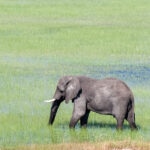The BBVA Foundation Frontiers of Knowledge award goes to Ceballos and Dirzo, for successfully quantifying the scale of the extinction of species brought about by human activity
The research undertaken by Mexican ecologists Gerardo Ceballos (National Autonomous University of Mexico) and Rodolfo Dirzo (Stanford University) in Latin America and Africa has shown that the current species extinction rates in many groups of organisms are much higher than throughout the preceding two million years, according to the committee of the BBVA Foundation Frontiers of Knowledge Award in Ecology and Conservation Biology.

By documenting losses of animals and plants in some of the Earth’s most biodiverse habitats, both Ceballos and Dirzo have contributed to showing that today’s biodiversity crisis is, as the citation states, “an especially rapid period of species loss occurring globally and across all groups of organisms, and the first to be tied directly to the impacts of a single species, namely, us.”
The two awardee ecologists have catalyzed the global study of ‘defaunation,’ a term Dirzo coined to describe the alterations causing the disappearance of animals in the structure and function of ecosystems. His research, says the citation, has revealed how the elimination of a single species can trigger pernicious ‘cascading effects’ by disrupting the web of interactions it maintains with other organisms. This, in turn, has adverse effects on human wellbeing through the reduction of the goods and services they perform. His work has helped provide the “necessary scientific basis” to further the adoption of evidence-led conservation measures.
An extinction rate between 100 and 1,000 times greater
Ceballos turned his research attention to the study of wildlife and the magnitude of the advancing extinction, while Dirzo centered his efforts on ecological interactions between plants and animals, and the consequences of this extinction.
Ceballos’ work on assessing current rates of extinction led him to explore comparisons with the rates of the past. “Evolution operates as a process of species extinction and generation. In normal periods, more species appear than disappear, such that diversity gradually expands. There have been five mass extinction events in the last 600 million years, the last of which brought the demise of the dinosaurs. All had in common that they were catastrophic – wiping out 70 percent or more of the world’s species – had their origins in natural disasters, like a meteorite collision, and were extremely rapid in geological terms, lasting hundreds of thousands or millions of years,” he explains.
Vertebrate extinction rates now are from 100 to 1,000 times greater than those prevailing over the last few million years. “What this means is that the vertebrate species that have died out in the past 100 years should have taken 10,000 years to become extinct. That is the magnitude of the extinction,” he explains.

Gerardo Ceballos (National Autonomous University of Mexico). - BBVA Foundation
The biodiversity crisis as important as climate change
Species extinction is the last stage in the process, but Ceballos insists that population extinction is no less worrying, since it is these populations that provide environmental services on a local or regional scale.
“It doesn’t matter if there are jaguars in Brazil if they have died out in Mexico, because the environmental services they performed in Mexico will have disappeared with them.” Ceballos and his colleagues explored this concept in a study of prairie dog populations, which in the 1990s were thought to be pests and were the target of eradication campaigns.
Through this study, they were able to prove that, rather than pests, they actually play a vital role in maintaining their ecosystem, the grasslands of the southwest of the United States and north of Mexico. With these rodents gone, the soil becomes less fertile, erosion increases and the scrubland advances, wiping out the plants that serve as forage for livestock. “The impact on environmental services is colossal,” he affirms.
For the Mexican ecologist, the biodiversity crisis we are experiencing is of a magnitude similar to the crisis of climate change: “We have to couple the issue of species extinction with the issue of climate change, and understand that it is a threat to humanity’s future.”

Rodolfo Dirzo (Stanford University). - BBVA Foundation
From deforestation to ‘defaunation’
Dirzo came up with the term ‘defaunation’ to refer to the imbalance entailed by the absence of animals in an ecosystem. “Everyone has a mental picture when they hear the word deforestation. They understand that what they are seeing is a problem, the erosion of ecosystems due to loss of vegetation. And it occurred to me that the word ‘defaunation’ could be a way to highlight that, just as Earth’s ecosystems face a serious problem of deforestation, another serious threat lies in the depletion and possible extinction of animal species,” remarks Dirzo.
“Species do not live in an ecological vacuum,” he points out, insisting that it is not just species disappearances we have to worry about, but the extinction of species populations and, above all, species interactions, which should accordingly be a core focus of conservation actions.
“Imagine that we eliminate the elephants, giraffes, zebras and buffalos from an African savannah, all the large vertebrates that define the savannah’s function. Without these animals, plants at ground level will grow much more, soil compaction will lessen, fruits and seeds will fall from the trees without being eaten, and will pile up on the ground instead of having animals disperse them by ingestion and transport.”
Poaching and the risk of pandemics
These effects, Dirzo explains, give rise to a phenomenon that he refers to as “winners and losers.” When large animals like elephants die out locally, they are evidently losers, while smaller animals like rodents take advantage of their absence and therefore become winners. But these smaller animals also carry pathogens like Leptospira, Leishmania and even the bacteria that causes bubonic plague. So if populations of these pathogen-carrying animals increase, there is a greater chance that they will transmit diseases to humans. “We could be put at risk of suffering a new pandemic,” he affirms, “given the proliferation of these diseases and the current mobility of human beings.”
His research in Africa has reliably shown that there is “a cascade that runs from elephant poaching to the real risk of a new human pandemic.”
Hunting is just one human activity that can drive species populations totally or partially extinct and trigger such grave effects as a pandemic.
Dirzo lists five key factors that drive defaunation: land use change for pasture or urban development; the overexploitation of resources; pollution – by anything from noxious chemical products to marine plastic waste; the introduction of non-native or invasive species in ecosystems where they don’t belong; and climate change. “But none of these five factors,” he adds, “operates in isolation: they are all interlinked, and this makes the challenge of dealing with biological extinction all the more complex.”